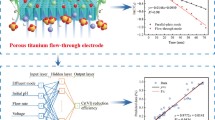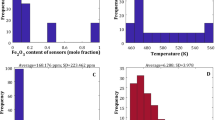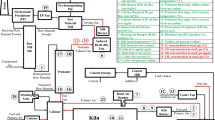Abstract
Prediction of current-voltage characteristics of chemical PbPc sensors with different inter-electrode separation using Neural Networks is carried out successfully. The main purpose of the work is to determine in advance device properties such as current and voltage based on available test data, without the need to build the device. Thus, modification of the design can be carried out based on the optimized and predicted values produced by the Neural Networks model. The produced devices have capabilities to detect small amounts of NO2, which is considered a hazardous gas emitted by various vehicles and can cause undesirable pollution. The used Weight Elimination Algorithm (WEA), proved that as the inter-electrode separation increases, the injected current as a function of applied voltage will also increase, due to more available surface area of vacuum sublimed PbPc material. Also, the response showed non-linearity at larger inter-electrode separations due to separation values and increased bulk interaction effect in addition to the surface interaction of charge transfer. The main benefit of Neural Networks model is to predict values resulting from complex mechanisms, which, otherwise hard to evaluate and model.
Access this chapter
Tax calculation will be finalised at checkout
Purchases are for personal use only
Similar content being viewed by others
References
Hany, R., Cremona, M., Strassel, K.: Recent advances with optical upconverters made from all-organic and hybrid materials. Sci. Technol. Adv. Mater. 20, 496–510 (2019)
Nazemi, H., Joseph, A., Park, J., Emadi, A.: Advanced micro-and nano-gas sensor technology: a review. Sensors 19(1285), 1–23 (2019)
Ding, R., Xu, Z., Zheng, T., Huang, F., Peng, Y., Lv, W., Yang, Y., Wang, Y., Xu, S., Sun, L.: Realizing high-responsive superlattice organic photodiodes by C 60 and zinc phthalocyanine. J. Mater. Sci. 54(4), 3187–3195 (2019)
Li, Y., Wang, B., Yu, Z., Zhou, X., Kang, D., Wu, Y., He, C., Zhou, X.: The effects of central metals on ammonia sensing of metallophthalocyanines covalently bonded to graphene oxide hybrids. RSC Adv. 7, 34215–34225 (2017)
Govardhan, K., Nirmala, A.: Temperature optimized ammonia and ethanol sensing using ce doped tin oxide thin films in a novel flow metric gas sensing chambers. J. Sens. 2016, 1–12 (2016). Article ID 7652450
Yan, J., Guo, X., Duan, S., Jia, P., Wang, L., Peng, C., Zhang, S.: Electronic nose feature extraction methods: a review. Sensors 15(11), 27804–27831 (2015)
Vishesh, S., Srinath, M., Gubbi, K., Shivu, H., Prashanta, N.: Portable low cost electronic nose for instant and wireless monitoring of emission levels of vehicles using android mobile application. Int. J. Adv. Res. Comput. Commun. Eng. 5(9), 134–140 (2016)
Suganya, R., Uthayakumar, R.: Electronic nose for accident prevention and vehicleblack box system 4(5), 1206–1209 (2015)
Guentner, A., Koren, V., Chikkadi, K., Righettoni, R., Pratsinis, S.E.: E-nose sensing of low-ppb formaldehyde in gas mixtures at high relative humidity for breath screening of lung cancer. ACS Sens. 1(5), 528–535 (2016)
Sun, Y., Luo, D., Li, H., Zhu, C., Xu, O., Hosseini, H.: Detecting and identifying industrial gases by a method based on olfactory machine at different concentrations. J. Electric. Comput. Eng. 2018, 1–9 (2018). Article ID 1092718
Tiele, A., Esfahani, S., Covington, J.: Design and development of a low-cost, portable monitoring device for indoor environment quality. J. Sens. 2018, 1–14 (2018). Article ID 5353816
Yan, K., Zhang, D.: Calibration transfer and drift compensation of e-noses via coupled task learning. Sens. Actuators B Chem. 225, 288–297 (2016)
Ma, Z., Luo, G., Qin, K., Wang, N., Niu, W.: Weighted domain transfer extreme learning machine and its online version for gas sensor drift compensation in e-nose systems. Wirel. Commun. Mob. Comput. 2018, 1–17 (2018). Article ID 2308237
Di Gilio, A., Palmisani, J., de Gennaro, G.: An innovative methodological approach for monitoring and chemical characterization of odors around industrial sites. Adv. Meteorol. 2018, 1–8 (2018). Article ID 1567146
Wu, Y., Liu, T., Ling, S., Szymanski, J., Zhang, W., Su, S.: Air quality monitoring for vulnerable groups in residential environments using a multiple hazard gas detector. Sensors 19(362), 1–16 (2019)
Guerrero-Ibáñez, J., Zeadally, S., Contreras-Castillo, J.: Sensor technologies for intelligent transportation systems. Sensors 18(1212), 1–24 (2018)
Iskandarani, M.: Two dimensional electronic nose for vehicular central locking system (E-Nose-V). Int. J. Adv. Comput. Sci. Appl. 10(6), 63–70 (2019)
Author information
Authors and Affiliations
Corresponding author
Editor information
Editors and Affiliations
Rights and permissions
Copyright information
© 2020 Springer Nature Switzerland AG
About this paper
Cite this paper
Iskandarani, M.Z. (2020). Application of Neural Networks to Characterization of Chemical Sensors. In: Arai, K., Kapoor, S., Bhatia, R. (eds) Intelligent Computing. SAI 2020. Advances in Intelligent Systems and Computing, vol 1230. Springer, Cham. https://doi.org/10.1007/978-3-030-52243-8_5
Download citation
DOI: https://doi.org/10.1007/978-3-030-52243-8_5
Published:
Publisher Name: Springer, Cham
Print ISBN: 978-3-030-52242-1
Online ISBN: 978-3-030-52243-8
eBook Packages: Intelligent Technologies and RoboticsIntelligent Technologies and Robotics (R0)




